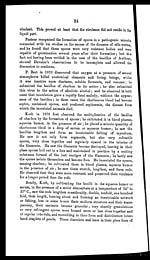Medicine - Veterinary > Civil Veterinary Departments > Civil Veterinary Department ledger series I-VI > Volume II - Anthrax
(141) Page 23
Download files
Individual page:
Thumbnail gallery: Grid view | List view

23
Jaillard and Leplat obtained a malady which killed, in the same
manner as charbon, but without bacilli, by inoculating charbonous blood
taken from a cadaver in course of putrefaction which did not present
bacilli in rods; and they concluded that the rod could not be consi-
dered as the morbific agent of charbon. Davaine then distinguished
charbon due to rods (bacteridia) and the pretented or so-called charbon
without bacteridia, to which he gave the name of "maladie dela vache;"
he considered the latter to be a special malady, of a septic nature, killing
more quickly than charbon and inoculable to birds.— (Comptes rendus
de l'Academie des Sciences, 1864 to 1873.)
The facts opposed to the theory of Davaine are easily explained
to-day; the bacilli may produce spores under certain conditions, before
their destruction in the cadavers. On the other hand, the bacteria of
putrefaction, which are found in the digestive passages, very promptly
invade the various parts of the cadaver and likewise form spores. Also
in examining charbonous blood taken from a cadaver in course of putre-
faction, we may observe neither the rods of charbon nor septic bacteria
nor vibriones on account of their extreme refractility; in addition to
which we do not distinguish, by microscopical examination, the spores of
one bacterium from those of another. It occasionally happens that the
germs of charbon and septic germs are inoculated together; it is
generally septicæmia which develops under these circumstances, and
consequently the rods of charbon do not appear in the blood. If
the spores develop, producing charbon, we obtain the bacilli without
having inoculated the rods. If, then, charbonous cadavers remain viru-
lent for a long time in the soil, it is because the bacilli, before disappear-
ing, form spores which are very resistant. In addition to this, it is not
only the charbonous blood which becomes rapidly septic after death ;
that of animals dead of other diseases becomes so after a few hours.
Brauell considered the bacillus as the diagnostic criterium of char-
bon, but he did not regard it as the cause of the malady; he recognized
in 1865 that the pig was refractory to inoculation.
Luton in 1869 found, as Davaine had found, that dried charbonous
blood retained its virulence.
Baillet observed a bacillus in the blood of all animals dead of "Mal
de Montagne," which was recognized as charbonous by a Commission
which was sent into the Cantal and the Puy de Dôme to study it. He
supposed that the bacteridia or their germs, owing to the custom which
prevailed of burying the animals in shallow graves in the pastures, lived
on the soil and plants and were introduced with the forage.
In 1871, Klebs and Tiegel, having filtered charbonous blood through
a clay filter, found that the plasma obtained without rods was not
Set display mode to: Large image | Zoom image | Transcription
Images and transcriptions on this page, including medium image downloads, may be used under the Creative Commons Attribution 4.0 International Licence unless otherwise stated. ![]()
| India Papers > Medicine - Veterinary > Civil Veterinary Departments > Civil Veterinary Department ledger series I-VI > Anthrax > (141) Page 23 |
|---|
| Permanent URL | https://digital.nls.uk/75516195 |
|---|




